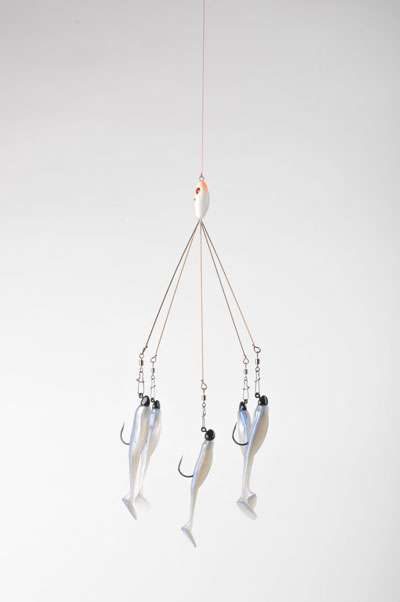
Editor’s Note: Anglers beware. This is a rapidly changing area of the law and the regulations in your state may have changed or may be changing soon. To ensure that you are within the law, check with your state and local fish and game departments.
The Alabama Rig runs into problems with certain state laws because it consists of more hooks per line than is allowed in those waters. Similar to the standard umbrella rig used for gamefish such as stripers, the Alabama Rig is made of a single metal rod attached to a plastic head with five wires extending from the back of the head. A lure can be attached to each of the five wires.
“Our striped bass anglers have used ‘umbrella rigs’ for years,” said Colton Dennis, black bass program supervisor for the Arkansas Game and Fish Commission. “We don’t have any regulation for an angler fishing with multiple lures or multiple hooks.”
In addition to Arkansas, other states that allow the five-lure version of the Alabama rig include Alabama, Kentucky, Louisiana, Idaho, New Mexico, Oklahoma, Florida, Connecticut, Texas, North Carolina, Michigan and New York, according to spokesmen for those states’ fisheries departments.
New Jersey allows the rig on most state waters except the Delaware River, which has a restriction of three hooks per line. Mississippi also permits the rig to be used on most waters except the lakes of Arkabutla, Grenada, Enid and Sardis and the spillways of Arkabutla, Grenada, Enid, Sardis, Okatibbee and Ross Barnett reservoirs, according to Larry Pugh, fisheries bureau assistant director for the state’s department of Wildlife, Fisheries and Parks. “We have a crappie regulation on those four lakes that says anglers may fish with no more than three or five poles and each pole may have no more than two hooks/lures. So that law includes the Alabama rig on those lakes,” Pugh said.
The Tennessee Wildlife Resources Agency issued a statement that an umbrella rig, which it defines as “an array of more than three artificial lures or baits (with or without hooks) used by a single rod and reel combination,” cannot contain hooks of Size 6 or larger. The agency stated if an angler reduces the number of baits attached to the Alabama Rig to three or fewer, it would not meet the definition of an umbrella rig and then could be fished with any size or style of hook.
Some states, such as Missouri, allow only three hooks per line. To comply with the state law, some anglers are setting up their Alabama rigs with three lures with hooks and two lure bodies without hooks that serve as decoys. Other states restricting rigs to three hooks or fewer include Colorado, Ohio, Rhode Island, Washington, California, Pennsylvania, Wisconsin and Utah.
Indiana allows an angler to fish no more than two hooks or two artificial baits or harnesses per line, which would seem to make the Alabama rig illegal. However the Indiana Department of Natural Resources is reviewing the legality of the rig.
“The question becomes is the Alabama rig one part with multiple lures or one lure with multiple parts,” said Major Terry Hyndman, Indiana conservation officers operations commander. “Personnel from our agency have discussed this topic in length, and although we believe that the original intent of our rule was to prohibit this type of fishing device, we’re not convinced that the language is clear enough to support prosecution. As such, our conservation officers have been instructed not to take any enforcement action until the issue is reviewed further.”
Illinois allows the full version of the Alabama rig on its larger reservoirs, but a “two pole and line” limit restricts usage of the rig on many waters managed by the Illinois Department of Natural Resources (IDNR). “Statewide the rule is you can use up to 50 hooks so the Alabama rig could be used in some Illinois waters but not those that have the two pole and line limit only because we only allow two hooks or lures per line there,” said Sgt. Roy Maul of the IDNR support services. A list of the waters with the two-hook restriction is available in the 2011 Illinois Fishing Information booklet on pages 10-33 (www.dnr.illinois.gov/fishing).
Arizona also limits offerings to two lures with hooks, according to Kirk Young, fisheries branch chief for the Arizona Game and Fish Department. “These ‘rigs’ with more than two lures would not be legal for angling in Arizona,” he said, adding that it is “my thought” that multiple soft baits can be included in a rig as long as no more than two have hooks.
States in which an Alabama rig with three hooks or more is considered illegal include New Hampshire, Minnesota, Iowa, Kansas, Nebraska, Massachusetts, Nevada, Vermont and Maryland.

